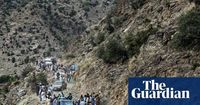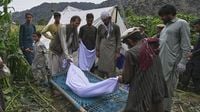In the early hours of Sunday, September 1, 2025, as most of Afghanistan slept, a powerful 6.0 magnitude earthquake ripped through the country’s mountainous eastern provinces near the border with Pakistan. According to the U.S. Geological Survey and corroborated by multiple news outlets, the quake struck just before midnight, its epicenter situated in the rugged terrain of Kunar and Nangarhar provinces. By Thursday, September 4, the death toll had climbed to at least 2,205, with another 3,640 people injured—a staggering figure that continues to rise as rescue teams sift through the debris.
The quake was shallow, with its epicenter only about eight kilometers (five miles) deep, making its destructive power all the more intense. As reported by the Associated Press, the disaster leveled entire villages, burying families and livestock under heaps of rubble and triggering deadly landslides. “All the rocks came down from the mountain,” recalled Muhammad Israel, a survivor from Kunar. “I barely got my children out of there. ... The earthquake jolts are still happening. It is impossible to live there.”
In the days that followed, Afghanistan was rocked by a series of aftershocks. A 5.2 magnitude tremor struck on Tuesday about 20 miles northeast of Jalalabad, and then, late Thursday, a 5.6 magnitude earthquake rattled the region again. The BBC reports that this third quake—occurring at 20:56 local time—sent terrified residents fleeing from makeshift shelters into the open. Medics in Kunar told the BBC that at least 17 wounded people were brought to the provincial hospital after Thursday’s quake, though no new deaths were immediately reported from this latest tremor.
The devastation is most acute in Kunar province, where, according to an assessment by the Islamic Relief charity, some 98% of buildings have been damaged or destroyed. These are regions where homes are often built from wood and mud-brick, perched along steep river valleys and separated by impassable mountains. The rough terrain has made rescue and relief operations almost impossible in places. As John Aylieff, the World Food Programme’s country director for Afghanistan, told Al Jazeera, “What we’re seeing on the ground is utter devastation, a real catastrophe. We have houses razed to the ground.”
Survivors, many of whom have lost entire families, have been forced to bury their loved ones in mass graves, following Islamic tradition for quick burials. Wazir, a 25-year-old resident, pointed to a row of fresh graves for Afghanistan’s TOLO News: “That is my daughter, the other is my sister. This grave is my brother’s, and that one is my mother’s and that is my father, along with my brother.”
Search and rescue efforts are ongoing, but the challenges are immense. Landslides and rockfalls have blocked roads, forcing emergency crews and aid workers to walk miles—sometimes more than 12—to reach the most isolated villages. The Taliban administration has deployed helicopters to airlift supplies and, in some cases, has had to lower commandos by rope when helicopters could not land. “One team had to walk for over 12 miles to reach villages cut off by rock falls, carrying medical equipment on their backs with the help of community members,” Save the Children said in a statement cited by CBS News.
The United Nations’ World Health Organization warned on Thursday that the number of dead and injured was likely to rise in the coming days, as entire families may still be buried under the rubble. More than 6,700 homes have been destroyed, leaving thousands homeless and exposed to harsh conditions. Hospitals are overwhelmed, with many patients in need of urgent surgery and critical care. Dr. Shamshair Khan, working at a U.N. camp in Nurgal, described the dire situation: “Neither these medicines are enough nor these services. These people need more medicine and tents. They need food and clean drinking water. These people are in great pain.”
International aid has begun to trickle in, but it is far from sufficient. The Taliban government—still unrecognized by most of the world—has appealed for global assistance. The UN has released emergency funds, and the UK has pledged £1 million ($1.3 million) in aid. Qatar’s minister of state for international cooperation, Maryam bint Ali bin Nasser Al Misnad, became the first high-ranking foreign official to visit Afghanistan since the quake, overseeing aid delivery in Kabul. Still, aid agencies are facing severe funding shortages. The Norwegian Refugee Council, for instance, has only $100,000 available for emergency response, with an immediate funding gap of $1.9 million, according to communications advisor Maisam Shafiey. “We will need to purchase items once we get the funding but this will take potentially weeks and people are in need now,” Shafiey said.
The World Food Programme’s supplies are only expected to last a few weeks. With roads blocked and villages inaccessible to even off-road vehicles, aid workers have resorted to using pack animals or relying on villagers themselves to carry food back to their communities. “Even our off-the-road trucks cannot get through, so we’re using every means possible, small pick-ups, pack animals, and even in some cases, villagers are coming down and carrying food back to the communities,” Aylieff told Al Jazeera.
Afghanistan’s vulnerability to earthquakes is well known. The country sits atop the collision zone of the Indian and Eurasian tectonic plates, making it prone to frequent and devastating seismic events. In 2023, more than 2,000 people were killed in Herat province by a series of earthquakes. The year before, a 6.1 magnitude quake in the east killed at least 1,000 and injured another 3,000. Yet, despite this history, most homes in the affected regions are not built to withstand such shocks, and the country’s ongoing humanitarian crisis—compounded by drought, economic instability, and the return of millions of refugees—has left local resources stretched to the breaking point.
The Taliban’s spokesman, Hamdullah Fitrat, announced via social media that “tents have been installed for displaced families in multiple locations, and the organized distribution of primary and urgent humanitarian assistance is currently underway.” But for many survivors, the help is coming too slowly. “The situation is also bad for us here, we don’t have shelter and are living under open skies,” said Muhammad Israel, now staying at a U.N. medical camp in Nurgal.
Political realities further complicate the relief effort. With most Western nations refusing to recognize the Taliban as Afghanistan’s legitimate government, securing international funding is a daunting challenge. As Torek Farhadi, a development economist and former IMF advisor, told CBS News, “The earthquake is another reminder that the people of Afghanistan suffer from not having a government recognized at the U.N. A number of international aid mechanisms such as World Bank financing would (otherwise) have activated to support the vulnerable.”
As the dust settles and aftershocks continue, Afghanistan faces not just the immediate aftermath of a natural disaster, but the compounded trauma of a nation already grappling with crisis upon crisis. For those who survived, the coming days will be defined by uncertainty, resilience, and the hope that help—however slow—will arrive.


